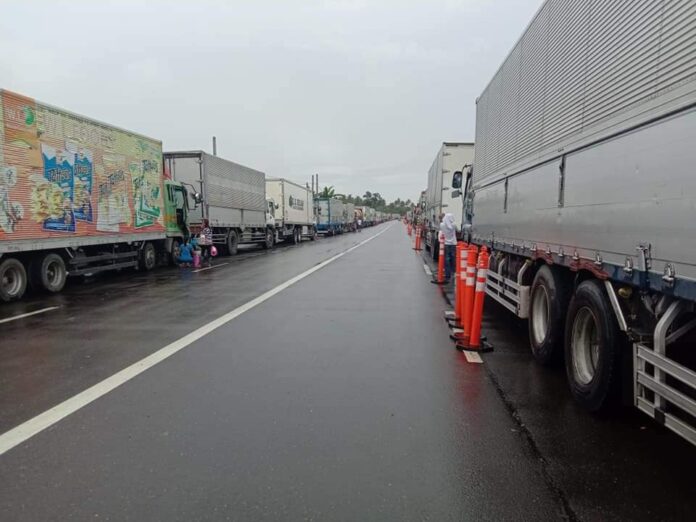
-
Measures have been laid out to address hampered shipping operations along the Matnog-Allen route due to perennial congestion and truck queueing
-
Financial assistance proposed to encourage shipping companies to ply the route
-
Opening of additional roro ramps and adoption of a maximum three-hour port stay rule also eyed
-
Implementation of a Terminal Appointment Booking System, a study on construction of a dry port/truck holding facility, and another study on port expansion through reclamation proposed
Maritime agencies have laid out measures to address hampered shipping operations along the Matnog-Allen route caused by perennial congestion and truck queueing along the road leading to Matnog Port.
Matnog Port is a vital port in Luzon as it is the jump-off port to the Visayas and Mindanao.
An inter-agency investigation revealed that Matnog port in Sorsogon suffers from a lack of roro (roll-on/roll-off) vessels to ferry trucks across San Bernardino Strait to Samar, the Philippine Ports Authority (PPA), Philippine Coast Guard (PCG), and Maritime Industry Authority (MARINA) said in a joint statement.
Only nine vessels with Certificates of Public Convenience (CPC) serviced the route from January 1 to March 17, 2021. At least 12 vessels should normally be operating on the route, the agencies noted. Non-operating vessels were reported to be either under repair or unable to sail as they are not equipped for harsh sea conditions.
To encourage more shipping operations on the Matnog-Allen route, MARINA and PPA will initiate a financial assistance program for shipping operators under Republic Act No. 11494 or Bayanihan to Recover as One Act (Bayanihan 2).
MARINA also advised shipping companies to increase trip frequency to compensate for vessel shortage, and replace dry-docked vessels to ensure stable operations of the route. It is likewise reviewing the schedule and number of trips per day of shipping companies under their CPCs.
The authorities said this has resulted in the increase in the number of vessels servicing the route to 10.
GT Express Shipping said it is willing to resume operations of its landing craft tank, Star Asia, which has a carrying capacity of 20 cargo trucks.
The authorities said they are confident the number of vessels being deployed “will be enough to make sure that cargo trucks can smoothly unload their cargo at the port and resolve the issue of queueing.”
PPA, meanwhile, recently opened two additional roro ramps, increasing Matnog port’s roro ramps to eight, to address the lack of infrastructure and increase port safety. The roro ramps consist of seven ramps for regular vessels and one specialized ramp for FastCat ferry boats.
Efficiency-raising measures
To improve efficiency, MARINA, PPA and PCG will also immediately do the following:
- PPA to implement a rule prescribing a maximum of three hours of port stay (including maneuvering time) to help define the average turnaround time of vessels, which is at least eight hours during normal sea and weather conditions
- MARINA to advise ships to complete three ships calls per day
- PCG to be the last to board and conduct clearance of vessel prior to scheduled departure to help enforce the three-hour maximum stay rule
Also proposed for approval of the Department of Transportation (DOTr) are the following:
- Ship calls to be increased based on the maximum shipping capacity in Matnog Port. If the maximum three-hour rule is implemented, one regular ramp can accommodate eight ship calls within 24 hours. Meanwhile, one specialized ramp for FastCat will accommodate three ship calls per day. Hence, the agencies can enforce 59 ship calls per day in normal sea and weather conditions.
- MARINA to provide at least 18 ships to maximize the shipping capacity of Matnog Port, with due consideration to the safety of navigation along the route.
- Alternate ports will be opened to divert other rolling cargoes. PPA has initially identified Bulan and Castilla Ports as possible alternative ports.
- PPA to implement a Terminal Appointment Booking System, a system already being implemented at Manila international terminals to spread out the entry and exit of trucks within the day and avoid truck queues.
- PPA to study the construction of a dry port/truck holding facility to decongest the highway leading to Matnog Port.
- PPA to study the expansion of the port through reclamation.
On the issue of “fixing” and corruption that compounds the problem of cargo truck queuing, the agencies noted this involves queuing of cargo trucks outside port premises. They said the Sorsogon Provincial Police has been tasked to implement the first in, first out (FIFO) policy to maintain orderly and efficient queuing of rolling cargoes along the highway.
The FIFO policy was implemented in December last year by the Sorsogon provincial government with port and maritime authorities in a bid to resolve the perennial problem of congestion and complaints against fixers.
“Hence, the policy and occurrences outside the port premises are beyond the control of the DOTr maritime sector agencies,” the agencies said.
Moreover, they noted that queuing of vehicles does not occur inside the port and all rolling cargoes allowed entry to the port have already secured slots on board vessels prior to entry.
Additional actions
Still, PPA, besides introducing the issuance of priority numbers to maintain orderly queuing, has deployed additional operations personnel and port police officers.
Additionally, PPA has engaged the public through an active information dissemination campaign on the process flow, as well as applicable fees of the port authority and shipping lines. Public notices have been posted along the highway, within the Matnog Terminal Complex, and the port premises.
Port police have been directed to remove unauthorized persons from the premises of Matnog Port. – Roumina Pablo




